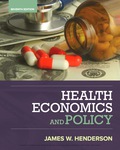
Subpart (a):
The preventive health care cost effectiveness.
Subpart (a):
Answer to Problem 3P
The total cost of 100 tests is $10,000. The total future medical expense averted is $15,000. The medical expense saved after setting up of the screening system is $5,000.
Explanation of Solution
The preventive health care measures are those medical precautionary measures which help the people to stay healthy and free from diseases. The screening system helps the people to easily identify and detect various diseases in their early stages which will help them to treat the diseases easily and affordably without much hassle.
The cost of one screening test is $100 according to the given information and the number of persons taking the screening test is 100. Thus, the total cost of taking the medical screening test can be calculated by multiplying the cost per screening test with the total number of persons taking the screening test as follows:
Thus, the total expense of 100 screening tests is $10,000.
The given percentage of persons having the test result positive is 15%. Thus, the total number of persons having positive test results can be calculated by multiplying the total number of persons with the given percentage as follows:
Thus, there will be 15 persons having the positive results from the screening test.
The amount of the future medical expense saved by the individual when the test result is positive is $1,000. Thus, the total future medical expense that can be saved by the people having the positive test results can be calculated by multiplying the per person medical expense saved with the total number of persons having positive test results as follows:
Thus, the total future medical expense saved by the persons having the positive test results is $15,000.
The cost of setting up the screening system is $10,000 and the total future medical expense saved is $15,000. Thus, the net future medical expense saved can be calculated by subtracting the cost of setting up the screening system from the total medical expense saved as follows:
Thus, the net medical expense saved after reducing the cost of setting up the screening test is $5,000.
Concept introduction:
Preventive health care: They are the measures taken in order to prevent the occurrence of a disease rather than treatment of a disease.
Sub part (b):
The net medical expense loss after reducing the cost of screening test.
Sub part (b):
Answer to Problem 3P
The total cost of 100 tests is $10,000. The total future medical expense averted is $5,000. The medical expense lost after setting up of the screening system is -$5,000.
Explanation of Solution
The cost of one screening test is $100 according to the given information and the number of persons taking the screening test is 100. Thus, the total cost of taking the medical screening test can be calculated by multiplying the cost per screening test with the total number of persons taking the screening test as follows:
Thus, the total expense for 100 screening tests is $10,000.
The given percentage of persons having the test result as positive is 5%. Thus, the total number of persons having positive test results can be calculated by multiplying the total number of persons with the given percentage as follows:
Thus, there will be 5 persons having the positive results from the screening test.
The amount of the future medical expense saved by the individual when the test result is positive is $1,000. Thus, the total future medical expense saved by the people having the positive test results can be calculated by multiplying the per person medical expense saved with the total number of persons having positive test results as follows:
Thus, the total future medical expense saved by the persons having the positive test results is $5,000.
The cost of setting up the screening system is $10,000 and the total future medical expense saved is $5,000. Thus, the net future medical expense saved can be calculated by subtracting the cost of setting up the screening system from the total medical expense saved as follows:
Since the result is having a negative sign, it shows that the expense of setting up the screening system is higher than the benefit received from the use of the screening system. Thus, the net result is a loss. Thus, the net medical expense loss after reducing the cost of setting up the screening test is -$5,000.
Want to see more full solutions like this?
Chapter 24 Solutions
EBK MICROECONOMICS
- Please solve this, no words or explanations.arrow_forward17. Given that C=$700+0.8Y, I=$300, G=$600, what is Y if Y=C+I+G?arrow_forwardUse the Feynman technique throughout. Assume that you’re explaining the answer to someone who doesn’t know the topic at all. Write explanation in paragraphs and if you use currency use USD currency: 10. What is the mechanism or process that allows the expenditure multiplier to “work” in theKeynesian Cross Model? Explain and show both mathematically and graphically. What isthe underpinning assumption for the process to transpire?arrow_forward
- Use the Feynman technique throughout. Assume that you’reexplaining the answer to someone who doesn’t know the topic at all. Write it all in paragraphs: 2. Give an overview of the equation of exchange (EoE) as used by Classical Theory. Now,carefully explain each variable in the EoE. What is meant by the “quantity theory of money”and how is it different from or the same as the equation of exchange?arrow_forwardZbsbwhjw8272:shbwhahwh Zbsbwhjw8272:shbwhahwh Zbsbwhjw8272:shbwhahwhZbsbwhjw8272:shbwhahwhZbsbwhjw8272:shbwhahwharrow_forwardUse the Feynman technique throughout. Assume that you’re explaining the answer to someone who doesn’t know the topic at all:arrow_forward
- Use the Feynman technique throughout. Assume that you’reexplaining the answer to someone who doesn’t know the topic at all: 4. Draw a Keynesian AD curve in P – Y space and list the shift factors that will shift theKeynesian AD curve upward and to the right. Draw a separate Classical AD curve in P – Yspace and list the shift factors that will shift the Classical AD curve upward and to the right.arrow_forwardUse the Feynman technique throughout. Assume that you’re explaining the answer to someone who doesn’t know the topic at all: 10. What is the mechanism or process that allows the expenditure multiplier to “work” in theKeynesian Cross Model? Explain and show both mathematically and graphically. What isthe underpinning assumption for the process to transpire?arrow_forwardUse the Feynman technique throughout. Assume that you’re explaining the answer to someone who doesn’t know the topic at all: 15. How is the Keynesian expenditure multiplier implicit in the Keynesian version of the AD/ASmodel? Explain and show mathematically. (note: this is a tough one)arrow_forward
- Use the Feynman technique throughout. Assume that you’re explaining the answer to someone who doesn’t know the topic at all: 13. What would happen to the net exports function in Europe and the US respectively if thedemand for dollars rises worldwide? Explain why.arrow_forward20. Given the mathematical model below, solve for the expenditure multiplier for a) government spending, G; and b) for consumer taxes, T. (medium difficulty) Y=C+I+G C=Co+b(Y-T) 1 = 10 T=To+tY G = Go+gYarrow_forwardUse the Feynman technique throughout. Assume that you’re explaining the answer to someone who doesn’t know the topic at all: 11. What exactly is a rectangular hyperbola and what relevance is it to classical economics?arrow_forward

 Exploring EconomicsEconomicsISBN:9781544336329Author:Robert L. SextonPublisher:SAGE Publications, Inc
Exploring EconomicsEconomicsISBN:9781544336329Author:Robert L. SextonPublisher:SAGE Publications, Inc Principles of Economics, 7th Edition (MindTap Cou...EconomicsISBN:9781285165875Author:N. Gregory MankiwPublisher:Cengage Learning
Principles of Economics, 7th Edition (MindTap Cou...EconomicsISBN:9781285165875Author:N. Gregory MankiwPublisher:Cengage Learning Principles of Economics 2eEconomicsISBN:9781947172364Author:Steven A. Greenlaw; David ShapiroPublisher:OpenStax
Principles of Economics 2eEconomicsISBN:9781947172364Author:Steven A. Greenlaw; David ShapiroPublisher:OpenStax Economics (MindTap Course List)EconomicsISBN:9781337617383Author:Roger A. ArnoldPublisher:Cengage Learning
Economics (MindTap Course List)EconomicsISBN:9781337617383Author:Roger A. ArnoldPublisher:Cengage Learning





